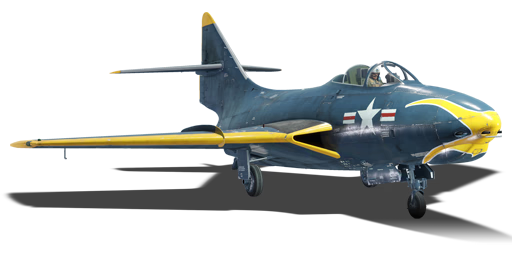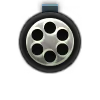



The F9F-8 (Design 99) was Grumman's final fighter iteration of the Cougar. It was intended to have improved flight characteristics such as a lower stall speed and better control at high angles of attack. The wing had a thinner cross section which increased the top speed. In addition, the center fuselage was increased by 8 inches which helped with the stall speed. Around 600 F9F-8s were delivered to the U.S. Navy. F9F-8 crews found the plane to be quite good and reliable: however, new supersonic jets quickly made the Cougar obsolete and its service was cut short. Some F9Fs were to be utilized as trainer aircraft, but no Cougars would actively serve in the Vietnam War.
Introduced in Update 1.63 "Desert Hunters", the F9F-8 is a good aircraft thanks to its improvements over the previous F9Fs and access to Sidewinders. The F9F-8 can carry bombs, rockets, and four AIM-9B missiles. Although AIM-9Bs are relatively weak, at the Cougar's BR they are quite handy in making opponents lose energy or quickly dispatching a slow target. Furthermore, the Cougar has four 20 mm cannons mounted in the chin of the aircraft which is incredibly lethal to fighters. Players should expect the F9F-8 to be a capable aircraft thanks to its weaponry and decent performance.
flaps
flaps
flaps
brake
| Belt | Belt filling | Armor penetration (mm) at a distance: | |||||
|---|---|---|---|---|---|---|---|
| 10 m | 100 m | 500 m | 1000 m | 1500 m | 2000 m | ||
| HEF-I/AP-T | 36 | 33 | 23 | 15 | 9 | 6 | |
| AP-T/AP-T/HEF-I/HEF-I | 36 | 33 | 23 | 15 | 9 | 6 | |
| HEF-I/HEF-I/HEF-I/AP-T | 36 | 33 | 23 | 15 | 9 | 6 | |
| AP-T/AP-T/AP-T/HEF-I | 36 | 33 | 23 | 15 | 9 | 6 | |
| HEF-I | 5 | 4 | 3 | 3 | 3 | 3 | |
| Belt | Belt filling | Armor penetration (mm) at a distance: | |||||
|---|---|---|---|---|---|---|---|
| 10 m | 100 m | 500 m | 1000 m | 1500 m | 2000 m | ||
| HEF-I/AP-T | 36 | 33 | 23 | 15 | 9 | 6 | |
| AP-T/AP-T/HEF-I/HEF-I | 36 | 33 | 23 | 15 | 9 | 6 | |
| HEF-I/HEF-I/HEF-I/AP-T | 36 | 33 | 23 | 15 | 9 | 6 | |
| AP-T/AP-T/AP-T/HEF-I | 36 | 33 | 23 | 15 | 9 | 6 | |
| HEF-I | 5 | 4 | 3 | 3 | 3 | 3 | |
| Name | Weight | Slot | ||||||
|---|---|---|---|---|---|---|---|---|
| 72.6 kg |  |  |  |  | ||||
| 7 × | 93.3 kg |  |  |  |  |  |  | |
| 19 × | 233.7 kg |  |  |  |  |  |  | |
| 242.6 kg |  |  |  |  |  |  | ||
| 446.8 kg |  |  | ||||||












Flight performance | |
|---|---|
Survivability |
|---|
Weaponry | ||
|---|---|---|